Hung-Yu Tseng
DGS-LRM: Real-Time Deformable 3D Gaussian Reconstruction From Monocular Videos
Jun 11, 2025
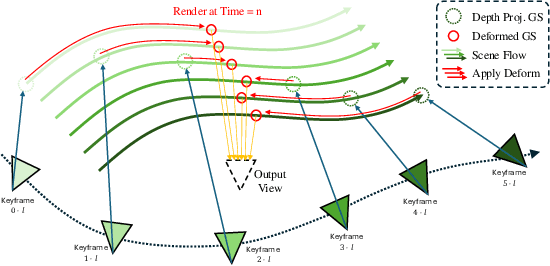
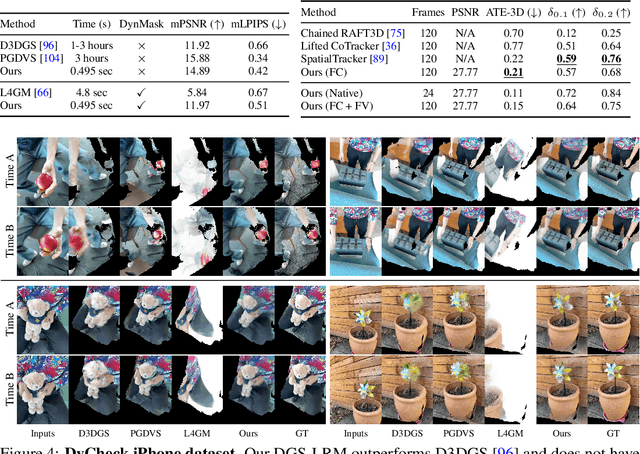

Abstract:We introduce the Deformable Gaussian Splats Large Reconstruction Model (DGS-LRM), the first feed-forward method predicting deformable 3D Gaussian splats from a monocular posed video of any dynamic scene. Feed-forward scene reconstruction has gained significant attention for its ability to rapidly create digital replicas of real-world environments. However, most existing models are limited to static scenes and fail to reconstruct the motion of moving objects. Developing a feed-forward model for dynamic scene reconstruction poses significant challenges, including the scarcity of training data and the need for appropriate 3D representations and training paradigms. To address these challenges, we introduce several key technical contributions: an enhanced large-scale synthetic dataset with ground-truth multi-view videos and dense 3D scene flow supervision; a per-pixel deformable 3D Gaussian representation that is easy to learn, supports high-quality dynamic view synthesis, and enables long-range 3D tracking; and a large transformer network that achieves real-time, generalizable dynamic scene reconstruction. Extensive qualitative and quantitative experiments demonstrate that DGS-LRM achieves dynamic scene reconstruction quality comparable to optimization-based methods, while significantly outperforming the state-of-the-art predictive dynamic reconstruction method on real-world examples. Its predicted physically grounded 3D deformation is accurate and can readily adapt for long-range 3D tracking tasks, achieving performance on par with state-of-the-art monocular video 3D tracking methods.
Textured Gaussians for Enhanced 3D Scene Appearance Modeling
Nov 27, 2024
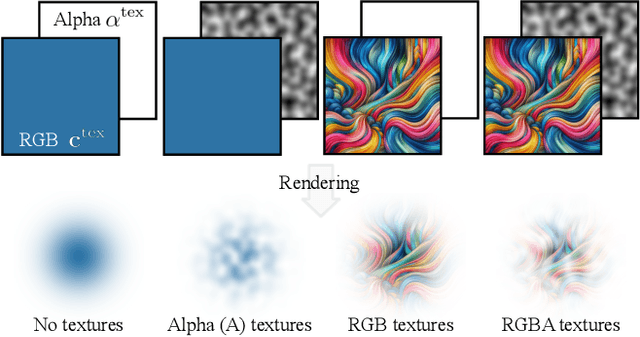

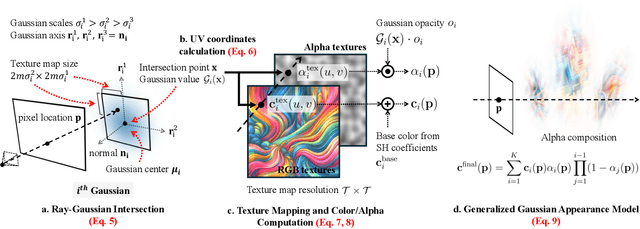
Abstract:3D Gaussian Splatting (3DGS) has recently emerged as a state-of-the-art 3D reconstruction and rendering technique due to its high-quality results and fast training and rendering time. However, pixels covered by the same Gaussian are always shaded in the same color up to a Gaussian falloff scaling factor. Furthermore, the finest geometric detail any individual Gaussian can represent is a simple ellipsoid. These properties of 3DGS greatly limit the expressivity of individual Gaussian primitives. To address these issues, we draw inspiration from texture and alpha mapping in traditional graphics and integrate it with 3DGS. Specifically, we propose a new generalized Gaussian appearance representation that augments each Gaussian with alpha~(A), RGB, or RGBA texture maps to model spatially varying color and opacity across the extent of each Gaussian. As such, each Gaussian can represent a richer set of texture patterns and geometric structures, instead of just a single color and ellipsoid as in naive Gaussian Splatting. Surprisingly, we found that the expressivity of Gaussians can be greatly improved by using alpha-only texture maps, and further augmenting Gaussians with RGB texture maps achieves the highest expressivity. We validate our method on a wide variety of standard benchmark datasets and our own custom captures at both the object and scene levels. We demonstrate image quality improvements over existing methods while using a similar or lower number of Gaussians.
Taming Latent Diffusion Model for Neural Radiance Field Inpainting
Apr 15, 2024Abstract:Neural Radiance Field (NeRF) is a representation for 3D reconstruction from multi-view images. Despite some recent work showing preliminary success in editing a reconstructed NeRF with diffusion prior, they remain struggling to synthesize reasonable geometry in completely uncovered regions. One major reason is the high diversity of synthetic contents from the diffusion model, which hinders the radiance field from converging to a crisp and deterministic geometry. Moreover, applying latent diffusion models on real data often yields a textural shift incoherent to the image condition due to auto-encoding errors. These two problems are further reinforced with the use of pixel-distance losses. To address these issues, we propose tempering the diffusion model's stochasticity with per-scene customization and mitigating the textural shift with masked adversarial training. During the analyses, we also found the commonly used pixel and perceptual losses are harmful in the NeRF inpainting task. Through rigorous experiments, our framework yields state-of-the-art NeRF inpainting results on various real-world scenes. Project page: https://hubert0527.github.io/MALD-NeRF
ViewDiff: 3D-Consistent Image Generation with Text-to-Image Models
Mar 04, 2024



Abstract:3D asset generation is getting massive amounts of attention, inspired by the recent success of text-guided 2D content creation. Existing text-to-3D methods use pretrained text-to-image diffusion models in an optimization problem or fine-tune them on synthetic data, which often results in non-photorealistic 3D objects without backgrounds. In this paper, we present a method that leverages pretrained text-to-image models as a prior, and learn to generate multi-view images in a single denoising process from real-world data. Concretely, we propose to integrate 3D volume-rendering and cross-frame-attention layers into each block of the existing U-Net network of the text-to-image model. Moreover, we design an autoregressive generation that renders more 3D-consistent images at any viewpoint. We train our model on real-world datasets of objects and showcase its capabilities to generate instances with a variety of high-quality shapes and textures in authentic surroundings. Compared to the existing methods, the results generated by our method are consistent, and have favorable visual quality (-30% FID, -37% KID).
Exploiting Diffusion Prior for Generalizable Pixel-Level Semantic Prediction
Nov 30, 2023Abstract:Contents generated by recent advanced Text-to-Image (T2I) diffusion models are sometimes too imaginative for existing off-the-shelf property semantic predictors to estimate due to the immitigable domain gap. We introduce DMP, a pipeline utilizing pre-trained T2I models as a prior for pixel-level semantic prediction tasks. To address the misalignment between deterministic prediction tasks and stochastic T2I models, we reformulate the diffusion process through a sequence of interpolations, establishing a deterministic mapping between input RGB images and output prediction distributions. To preserve generalizability, we use low-rank adaptation to fine-tune pre-trained models. Extensive experiments across five tasks, including 3D property estimation, semantic segmentation, and intrinsic image decomposition, showcase the efficacy of the proposed method. Despite limited-domain training data, the approach yields faithful estimations for arbitrary images, surpassing existing state-of-the-art algorithms.
Single-Image 3D Human Digitization with Shape-Guided Diffusion
Nov 15, 2023Abstract:We present an approach to generate a 360-degree view of a person with a consistent, high-resolution appearance from a single input image. NeRF and its variants typically require videos or images from different viewpoints. Most existing approaches taking monocular input either rely on ground-truth 3D scans for supervision or lack 3D consistency. While recent 3D generative models show promise of 3D consistent human digitization, these approaches do not generalize well to diverse clothing appearances, and the results lack photorealism. Unlike existing work, we utilize high-capacity 2D diffusion models pretrained for general image synthesis tasks as an appearance prior of clothed humans. To achieve better 3D consistency while retaining the input identity, we progressively synthesize multiple views of the human in the input image by inpainting missing regions with shape-guided diffusion conditioned on silhouette and surface normal. We then fuse these synthesized multi-view images via inverse rendering to obtain a fully textured high-resolution 3D mesh of the given person. Experiments show that our approach outperforms prior methods and achieves photorealistic 360-degree synthesis of a wide range of clothed humans with complex textures from a single image.
Motion-Conditioned Diffusion Model for Controllable Video Synthesis
Apr 27, 2023



Abstract:Recent advancements in diffusion models have greatly improved the quality and diversity of synthesized content. To harness the expressive power of diffusion models, researchers have explored various controllable mechanisms that allow users to intuitively guide the content synthesis process. Although the latest efforts have primarily focused on video synthesis, there has been a lack of effective methods for controlling and describing desired content and motion. In response to this gap, we introduce MCDiff, a conditional diffusion model that generates a video from a starting image frame and a set of strokes, which allow users to specify the intended content and dynamics for synthesis. To tackle the ambiguity of sparse motion inputs and achieve better synthesis quality, MCDiff first utilizes a flow completion model to predict the dense video motion based on the semantic understanding of the video frame and the sparse motion control. Then, the diffusion model synthesizes high-quality future frames to form the output video. We qualitatively and quantitatively show that MCDiff achieves the state-the-of-art visual quality in stroke-guided controllable video synthesis. Additional experiments on MPII Human Pose further exhibit the capability of our model on diverse content and motion synthesis.
Consistent View Synthesis with Pose-Guided Diffusion Models
Mar 30, 2023Abstract:Novel view synthesis from a single image has been a cornerstone problem for many Virtual Reality applications that provide immersive experiences. However, most existing techniques can only synthesize novel views within a limited range of camera motion or fail to generate consistent and high-quality novel views under significant camera movement. In this work, we propose a pose-guided diffusion model to generate a consistent long-term video of novel views from a single image. We design an attention layer that uses epipolar lines as constraints to facilitate the association between different viewpoints. Experimental results on synthetic and real-world datasets demonstrate the effectiveness of the proposed diffusion model against state-of-the-art transformer-based and GAN-based approaches.
Robust Dynamic Radiance Fields
Jan 05, 2023Abstract:Dynamic radiance field reconstruction methods aim to model the time-varying structure and appearance of a dynamic scene. Existing methods, however, assume that accurate camera poses can be reliably estimated by Structure from Motion (SfM) algorithms. These methods, thus, are unreliable as SfM algorithms often fail or produce erroneous poses on challenging videos with highly dynamic objects, poorly textured surfaces, and rotating camera motion. We address this robustness issue by jointly estimating the static and dynamic radiance fields along with the camera parameters (poses and focal length). We demonstrate the robustness of our approach via extensive quantitative and qualitative experiments. Our results show favorable performance over the state-of-the-art dynamic view synthesis methods.
Adaptively-Realistic Image Generation from Stroke and Sketch with Diffusion Model
Sep 01, 2022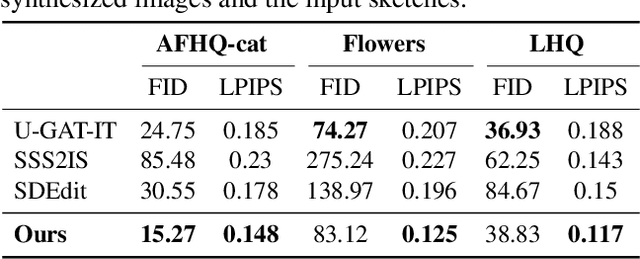


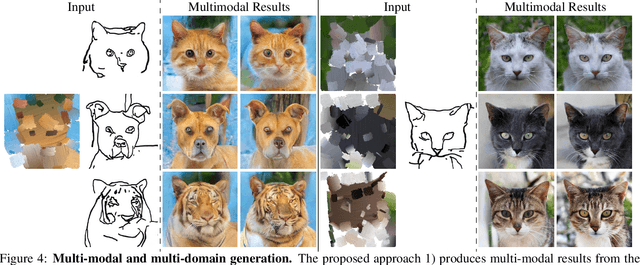
Abstract:Generating images from hand-drawings is a crucial and fundamental task in content creation. The translation is difficult as there exist infinite possibilities and the different users usually expect different outcomes. Therefore, we propose a unified framework supporting a three-dimensional control over the image synthesis from sketches and strokes based on diffusion models. Users can not only decide the level of faithfulness to the input strokes and sketches, but also the degree of realism, as the user inputs are usually not consistent with the real images. Qualitative and quantitative experiments demonstrate that our framework achieves state-of-the-art performance while providing flexibility in generating customized images with control over shape, color, and realism. Moreover, our method unleashes applications such as editing on real images, generation with partial sketches and strokes, and multi-domain multi-modal synthesis.
 Add to Chrome
Add to Chrome Add to Firefox
Add to Firefox Add to Edge
Add to Edge